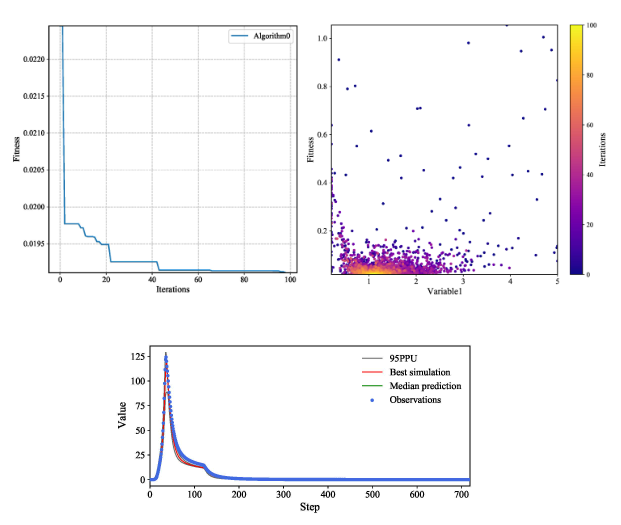An auto-calibration tool for environmental models based on heuristic algorithms and uncertainty estimation theory.
Project description
PyCUP
This is an open-source package designed for (environmental) model calibration and uncertainty analysis. The current version is the very first version, we welcome all comments, suggestions, and improvements.
v 0.1.7 Update
- A new superior algorithm MOMFO (multi-objective moth-flame optimizer) based on archive and crowding distance non-domination sort, and its elite-opposition improved version (EO-MOMFO) have been designed and provided in the new version. The elite opposition mechanism was modified based on the concept of non-domination and was embedded for updating the flame population of MOMFO. The implemented MOMFO has a similar principle as the current literature, although with some differences in details, while the elite-opposition version is original in this package.
- A "Mode" variable for MFO and MOMFO for switching the flame updating mechanism has been provided. A "Mode" value of 0 is for Mirjalili's original version, while a "Mode" value of 1 (default) is my modification. Details about the differences will be given in the upcoming algorithm introduction documentations.
What does it have
(1) For model calibration/optimization
- Single-objective heuristic algorithms including PSO, GWO, MFO, SOA, SCA, SSA, TSA, and WOA.
- Multi-objective heuristic algorithms including MOPSO, MODE, and NSGA-II.
- Elite opposition strategy modified heuristic algorithms -- with better optimum search abilities.
- Statistic based-method LHS-GLUE.
- Three kinds of algorithm border check mechanisms including Absorb, Random, and Rebound, designed for different problems.
(2) For sensitivity & uncertainty analysis
- Likelihood uncertainty estimation used in the GLUE framework for the parameter uncertainty analysis/prediction uncertainty estimation.
- The frequency based-uncertainty estimation method for the prediction uncertainty estimation.
- The multi-linear regression method for the all-at-a-time parameter sensitivity based on statmodels.
(3) Other convenient features
- Multi-processing calibration.
- Recording and resuming during the calibration task.
- Several result plotting functions.
- A special simulation result object for multi-station & multi-event results (of environmental models) in pycup.ResLib.
(4) Package/Tools integration
- PyCUP can be linked to spotpy database for post-processing, a pycup objective function can also be generated from the spotpy objective function using the module named pycup.integrate.
- A basic integration with PEST++ IO operations for model-agnostic calibrations. Details and limitations are provided in the specific documentation. The required objective function for pycup calibration can be easily generated using a PEST++ optimization project with/without a tsproc.exe. The PESTconvertor object in pycup.integrate provides several APIs for reading PEST++ files such as .pst, .ins, and .tpl.
How to install
The project has been uploaded onto the PyPI https://pypi.org/project/pycup/ . Or install the .whl file in the dist folder.
pip install pycup
How to use
Here is a simple example. For more details, please see the documentation.
import pycup as cp
import numpy as np
def uni_fun1(X):
# X for example np.array([1,2,3,...,30])
fitness = np.sum(np.power(X,2)) + 1 # example: 1.2
result = fitness.reshape(1,-1) # example ([1.2,])
return fitness,result
lb = -100 * np.ones(30)
ub = 100 * np.ones(30)
cp.SSA.run(pop = 1000, dim = 30, lb = lb, ub = ub, MaxIter = 30, fun = uni_fun1)
Example SWMM (Storm Water Management Model) calibration projects
IMPORTANT: PLEASE OPEN YOUR IDE (e.g. PYCHARM) OR COMMAND LINE WITH THE ADMINISTRATOR RIGHTS BEFORE EXECUTING THE EXAMPLE PROJECT
Location: https://github.com/QianyangWang/PyCUP
- The example in folder 'Example01-GLUE' contains an SWMM calibration project using single-processing GLUE. Install the dependencies (for example: pip install swmm-api==0.2.0.18.3, pip install pyswmm). Execute the 'Calibrate.py' to calibrate the model. Then, execute the 'PostProcessing.py' for uncertainty analysis.
- The example in folder 'Example02-multiprocessing' contains an SWMM calibration project using multi-processing EOGWO.
- The example in folder 'Example03-multiobjective' contains an SWMM multi-objective calibration project using EOMOPSO.
- The example in folder 'Example04-validation&prediction' shows how to use our (Ensemble)Validator/(Ensemble)Predictor objects for the validation and prediction of the model using the calibrated parameter (set).
- The example in folder 'Example05-multi-station&event' shows how to use the pycup.Reslib.SimulationResult object for the storage of multi-station & multi-event simulation results, as well as the further analysis using them.

Example PEST++ conversion project (with a Xinanjiang hydrologic model)
- The example in folder 'Example06-PESTintegration' contains a PEST++ Xinanjiang model calibration project and the python script to run a PyCUP calibration based on it.
Project details
Release history Release notifications | RSS feed
Download files
Download the file for your platform. If you're not sure which to choose, learn more about installing packages.
Source Distribution
Built Distribution
File details
Details for the file pycup-0.1.7.2.tar.gz.
File metadata
- Download URL: pycup-0.1.7.2.tar.gz
- Upload date:
- Size: 866.1 kB
- Tags: Source
- Uploaded using Trusted Publishing? No
- Uploaded via: twine/4.0.1 CPython/3.8.3
File hashes
| Algorithm | Hash digest | |
|---|---|---|
| SHA256 | 5fa88b87e93c3987496dc1b3a8b9320e18d4d62c2f5e9d0cef9765bd64140f92 |
|
| MD5 | 3c98fc567f9c800195ad14e3c2c45deb |
|
| BLAKE2b-256 | b6bf02ae31c4285ac8357d06a670d56549882ee134306e8bdae3239ee345aa19 |
File details
Details for the file pycup-0.1.7.2-py3-none-any.whl.
File metadata
- Download URL: pycup-0.1.7.2-py3-none-any.whl
- Upload date:
- Size: 891.0 kB
- Tags: Python 3
- Uploaded using Trusted Publishing? No
- Uploaded via: twine/4.0.1 CPython/3.8.3
File hashes
| Algorithm | Hash digest | |
|---|---|---|
| SHA256 | f8edc12d0ac3afabb92fca2590e3f0ff0f0bc498e6bcf089d949bb4322721e51 |
|
| MD5 | 893c59926f1ca81011cde80de5761484 |
|
| BLAKE2b-256 | 5e544d23077693c62dce1485d5bd93a443e1831109b56a91fb4fe9196a6420d2 |













